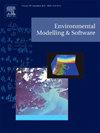Taxonomy of purposes, methods, and recommendations for vulnerability analysis
IF 4.8
2区 环境科学与生态学
Q1 COMPUTER SCIENCE, INTERDISCIPLINARY APPLICATIONS
引用次数: 0
Abstract
Vulnerability analysis is an emerging technique that discovers concise descriptions of the conditions that lead to decision-relevant outcomes (i.e., scenarios) by applying machine learning methods to a large ensemble of simulation model runs. This review organizes vulnerability analysis methods into a taxonomy and compares them in terms of interpretability, flexibility, and accuracy. Our review contextualizes interpretability in terms of five purposes for vulnerability analysis, such as adaptation systems and choosing between policies. We make recommendations for designing a vulnerability analysis that is interpretable for a specific purpose. Furthermore, a numerical experiment demonstrates how methods can be compared based on interpretability and accuracy. Several research opportunities are identified, including new developments in machine learning that could reduce computing requirements and improve interpretability. Throughout the review, a consistent example of reservoir operation policies in the Colorado River Basin illustrates the methods.
脆弱性分析的目的、方法和建议分类学
脆弱性分析是一种新兴技术,它通过将机器学习方法应用于大量的仿真模型运行集合,发现导致决策相关结果(即情景)的条件的简明描述。本综述将脆弱性分析方法归纳为一个分类法,并从可解释性、灵活性和准确性方面对其进行比较。我们的综述从脆弱性分析的五个目的(如适应系统和政策选择)的角度对可解释性进行了阐述。我们就如何设计可针对特定目的进行解释的脆弱性分析提出了建议。此外,一个数字实验展示了如何根据可解释性和准确性对各种方法进行比较。我们还指出了一些研究机会,包括机器学习的新发展,它们可以降低计算要求并提高可解释性。在整篇综述中,科罗拉多河流域水库运行政策的实例始终贯穿了这些方法。
本文章由计算机程序翻译,如有差异,请以英文原文为准。
求助全文
约1分钟内获得全文
求助全文
来源期刊

Environmental Modelling & Software
工程技术-工程:环境
CiteScore
9.30
自引率
8.20%
发文量
241
审稿时长
60 days
期刊介绍:
Environmental Modelling & Software publishes contributions, in the form of research articles, reviews and short communications, on recent advances in environmental modelling and/or software. The aim is to improve our capacity to represent, understand, predict or manage the behaviour of environmental systems at all practical scales, and to communicate those improvements to a wide scientific and professional audience.
 求助内容:
求助内容: 应助结果提醒方式:
应助结果提醒方式:


